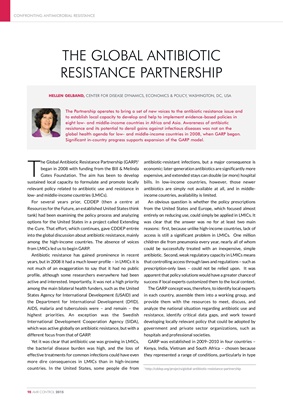
CONFRONTING ANTIMICROBIAL RESISTANCE
98 AMR CONTROL 2015
T
he Global Antibiotic Resistance Partnership (GARP)
1
began in 2008 with funding from the Bill & Melinda
Gates Foundation. The aim has been to develop
sustained local capacity to formulate and promote locally
relevant policy related to antibiotic use and resistance in
low- and middle-income countries (LMICs).
For several years prior, CDDEP (then a centre at
Resources for the Future, an established United States think
tank) had been examining the policy process and analyzing
options for the United States in a project called Extending
the Cure. That effort, which continues, gave CDDEP entrée
into the global discussion about antibiotic resistance, mainly
among the high-income countries. The absence of voices
from LMICs led us to begin GARP.
Antibiotic resistance has gained prominence in recent
years, but in 2008 it had a much lower profile - in LMICs it is
not much of an exaggeration to say that it had no public
profile, although some researchers everywhere had been
active and interested. Importantly, it was not a high priority
among the main bilateral health funders, such as the United
States Agency for International Development (USAID) and
the Department for International Development (DfID).
AIDS, malaria and tuberculosis were - and remain - the
highest priorities. An exception was the Swedish
International Development Cooperation Agency (SIDA),
which was active globally on antibiotic resistance, but with a
different focus from that of GARP.
Yet it was clear that antibiotic use was growing in LMICs,
the bacterial disease burden was high, and the loss of
effective treatments for common infections could have even
more dire consequences in LMICs than in high-income
countries. In the United States, some people die from
antibiotic-resistant infections, but a major consequence is
economic: later-generation antibiotics are significantly more
expensive, and extended stays can double (or more) hospital
bills. In low-income countries, however, those newer
antibiotics are simply not available at all, and in middleincome
countries, availability is limited.
An obvious question is whether the policy prescriptions
from the United States and Europe, which focused almost
entirely on reducing use, could simply be applied in LMICs. It
was clear that the answer was no for at least two main
reasons: first, because unlike high-income countries, lack of
access is still a significant problem in LMICs. One million
children die from pneumonia every year, nearly all of whom
could be successfully treated with an inexpensive, simple
antibiotic. Second, weak regulatory capacity in LMICs means
that controlling access through laws and regulations - such as
prescription-only laws - could not be relied upon. It was
apparent that policy solutions would have a greater chance of
success if local experts customized them to the local context.
The GARP concept was, therefore, to identify local experts
in each country, assemble them into a working group, and
provide them with the resources to meet, discuss, and
analyze the national situation regarding antibiotic use and
resistance, identify critical data gaps, and work toward
developing locally relevant policy that could be adopted by
government and private sector organizations, such as
hospitals and professional societies.
GARP was established in 2009-2010 in four countries -
Kenya, India, Vietnam and South Africa - chosen because
they represented a range of conditions, particularly in type
THE GLOBAL ANTIBIOTIC
RESISTANCE PARTNERSHIP
HELLEN GELBAND, CENTER FOR DISEASE DYNAMICS, ECONOMICS & POLICY, WASHINGTON, DC, USA
The Partnership operates to bring a set of new voices to the antibiotic resistance issue and
to establish local capacity to develop and help to implement evidence-based policies in
eight low- and middle-income countries in Africa and Asia. Awareness of antibiotic
resistance and its potential to derail gains against infectious diseases was not on the
global health agenda for low- and middle-income countries in 2008, when GARP began.
Significant in-country progress supports expansion of the GARP model.
1 http://cddep.org/projects/global-antibiotic-resistance-partnership